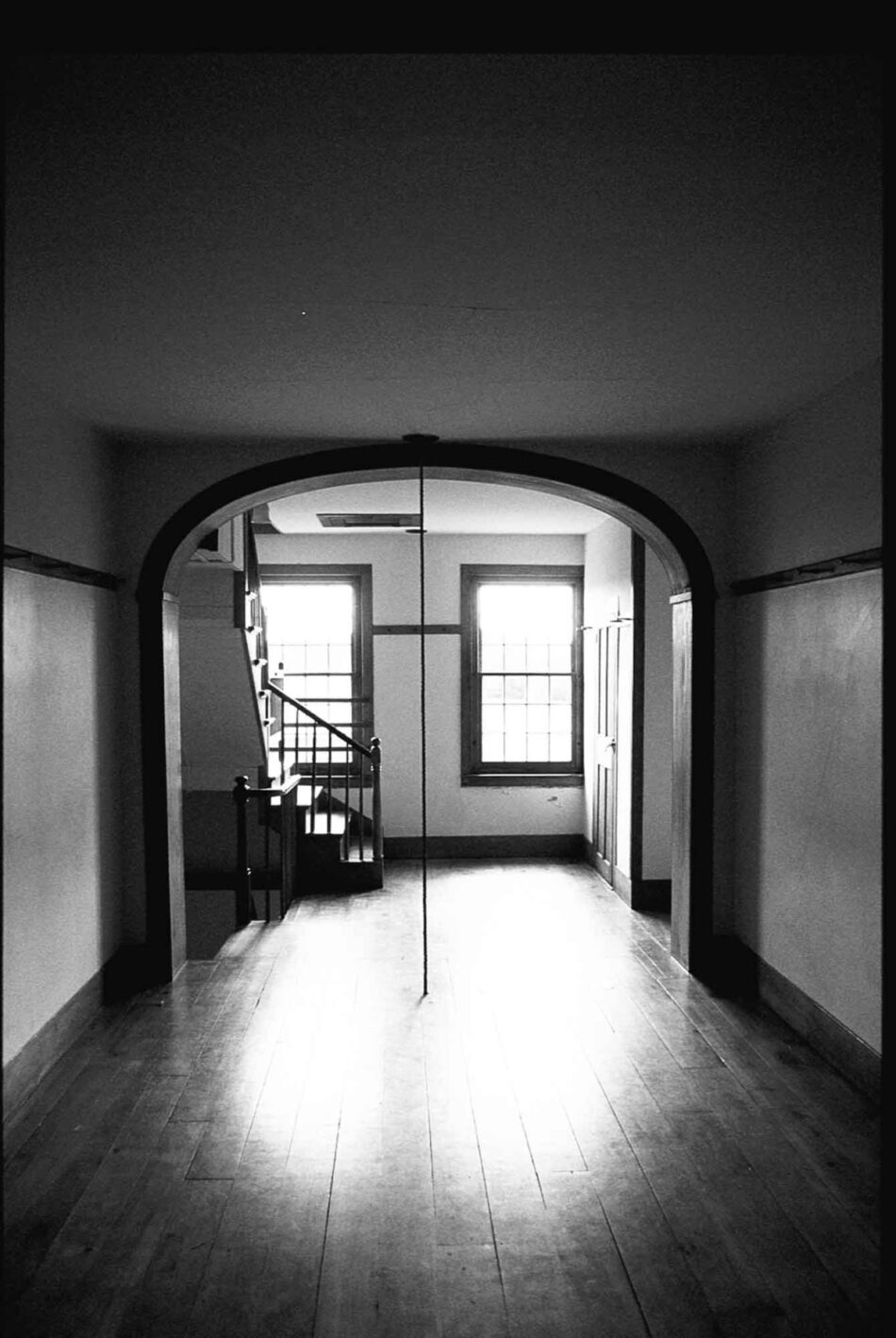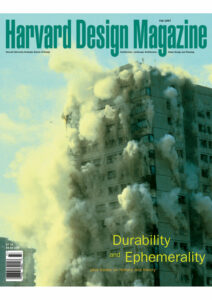Heimlich Manœoeuvers by Kari Jormakka
A drive across upstate New York last May gave me the opportunity to visit for the first time two of America’s best known examples of spiritual architecture—the Shaker village in New Lebanon and Louis Kahn’s First Unitarian Church in Rochester. Though built nearly two centuries apart for communities in many ways opposed in their religious views, the Shaker village and Kahn’s church share a striking number of architectural similarities, exemplifying above all the so-called American virtues of simplicity and functional directness. The Shakers were Kahn’s spiritual forebears both in the strong formal clarity of their architecture and their extraordinary inventiveness with materials and technology—each building beginning with a confident massing of volumes and spaces and ending with exquisitely resolved material details. We get the sense that, long before Kahn, the Shakers were able to divine as well “what the brick wants.” Kahn of course made no secret of his knowledge of and respect for traditional building craft, and the mastery of the Shaker woodworkers—their ability to join various pieces to create durable yet clean-lined cabinetry—may have inspired some of Kahn’s own details in wood.
I must admit that these comparisons had been on my mind even before visiting the buildings, and though confirmed by closer inspection, they were not particularly central to my thoughts while I was there on site. Instead, something rather different struck me as I wandered through these buildings—a heightened awareness of the architect’s control of spatial domain and the rules of perception. In the absence of obvious symbolism or of signs dictating a special code of behavior on the premises, both the village and the church sustain in their architecture unique visions of social order, originating in radical organizational schemes that resonate through every detail.
Founded in 1787, the Shaker village of New Lebanon was conceived as a self-contained utopian community in which all aspects of life were ruled by religious codes and customs, and architecture itself was called upon to reform and enforce the habits of the ideal community. Therefore, while the spiritual center of the village was the barrel-vaulted Meeting House where religious gatherings took place, it would be a mistake to say that the twenty-some other buildings (dormitories, farm buildings, and various workshops) that make up the community were not equally religious in nature. Emblematic of the role architecture played in reinforcing the Shakers’ spiritual beliefs was the all-pervading implied separation of spaces for men and women, which inspired a proportioning system whose fundamental premise was divisibility by two (not until Kahn’s day were ceremonial spaces again created in which it was psychologically so difficult to stand along the axis of symmetry). At the same time, the overwhelming functional and material inventiveness of Shaker builders testifies that the religious community’s outlook, while very strict, was also constantly searching and evolving in new directions.
The formal organization of Kahn’s church, on the other hand, owes more to the architect’s own sense of spiritual order than to the functional dictates of the religious sect. Kahn was particularly insistent on the center-periphery relationship of sanctuary and religious school, in contradiction to the congregation’s original wish for two separate entities, believing that his spatial configuration would promote a healthy symbiotic relationship between communal belief and individual questioning. Kahn’s vision of a peripheral passage for dissenting voices never quite achieved the assured formal resolution we might expect from him, resulting in an ambulatory that is dark and unlovely. And yet it is persuasive in other ways: as I sat through a meditative Sunday morning service in the sanctuary, I occasionally heard children chattering on the other side of the wall as they scampered unseen around these passages. Roving whispers and giggles enriched the sanctuary space in ways that no photograph can capture.
As paradigms of religious architecture, Kahn’s church and the various buildings of the Shaker village share something deeper than a mere symbolism of spiritual values; both complexes have their origins in proposing a radical way of organizing people and activities. Everything follows from this concept. Inventive multi-functional building elements—such as openings in walls, window seats, light wells—are striking not merely because of their expert formal and constructional resolution but because of the place that these elements find in the life of the building—the way that they actually generate their own necessity, or “rightness,” by creating new activities around them. In both cases, the clarity of the architect’s parti, with its implied divisions and overlaps between one group of activities and another, is not just a matter of giving symbolic form to an existing social organization; rather it is the result of actively creating this organization through a physical construction that excludes other potential perceptions of order. Kahn shared with the Shakers nothing less than a fervent belief in architecture as a pro-active force in shaping, rather than merely accommodating, society.
My tour across New York served as a rather timely prologue to reading Kari Jormakka’s new book, Heimlich Manœuvres: Ritual in Architectural Form—a brilliant extended essay emphasizing what the author terms the “performative role” of architecture. Based on a seminar Jormakka taught at the University in Weimar in 1995,Heimlich Manœuvres sets out to reveal those hidden aspects of architecture that frequently escape our notice and yet are actively engaged in shaping and maintaining our social and psychological patterns—much in the same way that linguistic conventions necessarily prejudice our thoughts.
A polyglot scholar who has taught in the United States, Germany, and his native Finland, Jormakka draws on his considerable knowledge of Indo-European languages to build a convincing case for this linguistically-inspired reading of architecture. In his search for the conceptual origins of architecture, the author excavates etymological roots with the assuredness of a veteran archaeologist. And though his own methods are deeply intertwined with linguistic theory, Jormakka cautions against relying too heavily on one aspect—semiotics—for the interpretation of architecture; representation and communication are, after all, only secondary functions of architecture. Before it is capable of carrying any symbolic meaning, he proposes, architecture must first actively organize our daily actions by creating and sustaining a set of fictional premises—arbitrary distinctions, divisions, confrontations—that we incorporate unconsciously into our view of the world.
Jormakka calls his approach “ritual constructionism”—ritual being precisely that aspect of architecture that is non-linguistic, non-referential. Ritual involves re-enactment rather than representation. In architecture we are all are participants; there is no passive audience capable of objective analysis. By definition, architecture limits our choice of actions and social groupings in particular spaces; it insidiously coerces us into re-enacting behavioral patterns which the builders have already foreseen for us. The various physical forms of our contemporary houses, apartment blocks, schools, offices—not to mention hundreds of more specialized building types—continue to promote certain social premises about grouping and dividing people and their activities, which the author methodically unveils, layer by layer, uncovering roots of human spatial behavior in built form.
What follows from his thesis is a fascinating and irresistibly unconventional approach to a few thousand of years of architectural history, an ambitious effort of reconstruction based on an interpretation of architecture’s most deeply embedded assumptions. Jormakka argues, for example, that the origin of society lies in the ritualized spatial segregation of men and women, which preceded even the most primitive building; enclosed space became necessary to civilization only after the first wave of agriculturalization made the twin concepts of privacy and ownership possible. While each of his arguments is tightly wrought, the author avoids presenting history in a hermetic chronology, preferring instead a more fragmented thematic approach that leaps about history and allows him to wrap up in just under 200 pages of insightful prose.
The story of architecture’s embedded rituals evolves into a gripping revisionist history of Western civilization, extending to present-day European and American culture. As Jormakka builds his argument, ritual escapes conventional definition, seeming to comprise all manner of encouraged social behavior whose root meaning is not made explicit; once any ritual is understood in rational or analytical terms, it no longer functions as ritual. He explains this key antithetical relationship between ritual and information in a memorable passage on totalizing institutions such as prisons and schools, where his theory’s debt to Foucault comes to the fore. Like Foucault, Jormakka appears to relish the prospect of unmasking modern civilization’s most unquestioned premises, revealing their secret origins while at the same time acknowledging the necessity of maintaining their fictional existence.
The essay’s enigmatic title is actually a play on words, whose key is contained in the two meanings of the word heimlich—German for “secret” but also originally “of the home.” The relationship of secrecy to the home is underlined in an early chapter entitled “House Rules,” where Jormakka’s analytical powers sweep cobwebs off the old family house. The chapter both refers to Heidegger’s search for the origins of the home in “dwelling” and reminds us how recent within the history of domestic architecture most of our current conceptions about family roles, the rooms of a house, and their separate functions may be. Tackling our domestic fictions room by room, this chapter speaks most directly of all to the power that architecture’s inscribed rituals exert over our daily lives.
Heimlich Manœuvres is a clever and insightful book of criticism, representing an impressive volume of scholarly research and a number of fresh observations on architecture. Jormakka’s critical attention to invisible assumptions embedded in known typologies and his ability to suggest yet unknown possibilities latent in certain forms provide fertile material for the thinking designer. If the architectural profession’s current identity crisis makes us question the relevance of architectural theory to society at large, the answer may be in part that we have forgotten the importance of—or relinquished responsibility for—critical foresight in testing the most unacknowledged assumptions regarding program, function, and human interaction in our buildings. Certainly, not every building task allows for radical re-organizational concepts from the architect; and yet Jormakka’s book makes us to pause to think how much more could be achieved if, like Kahn, we were able to begin each design from thoughts of architecture’s origins.

Before the pyramid age, the majority of the population in Egypt lived in more or less independent villages. During the annual flooding of the Nile, farmers could not work and used the time to raid other villages for cattle and women. The architect of the first pyramid, Imhotep, employed villagers during this restless time of tribal warfare. For three or four months every year, some 70,000 men took orders from the central administration and were fed and clothed by the administration. The government usurped the role of the villages and the tribes, creating the first nation state in history. When the centralized government was firmly established, the pyramid building stopped. The symbolic or referential meaning of the pyramid, whatever that may have been for the Egyptians, was used as a foil to avert gazes from its performative or ritualistic meaning, the consolidation of state power.
— Kari Jormakka
Mark Mulligan teaches a course on technology and architectural detailing at the GSD.
